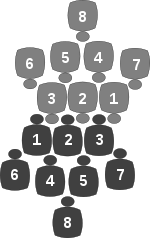Not much to add that others haven't said already. It's all about how a scrum is formed, with the front-rows offset slightly due to having to make room for the front rowers heads. This image shows what I mean:
As you see from above, the tightheads simply have more pressure coming through on them, because they receive the full force from the opposition looshead, but also some from the opposition hooker. A loosehead is only in contact with the opposition tighthead, and therefore doesn't need to be as good a scrummager.
This results in the different roles in open play. A tighthead's main job is to hold that scrum, and as such he's usually as powerful and compact as possible (tall tightheads can struggle to keep their backs straight). Because of this, his speed and agility is often compromised, just as an agile and quick winger concentrates on those aspects above power. The loosehead can get away with being not as strong a scrummager, and as such he can be a little more athletic, and train in a way to develop a little more speed and agility at the expense of a little scrummaging strength.
Of course there are exceptions to the rule. Dan Cole makes quite a good one, being a strong tighthead scrummager, and dynamic around the park.










